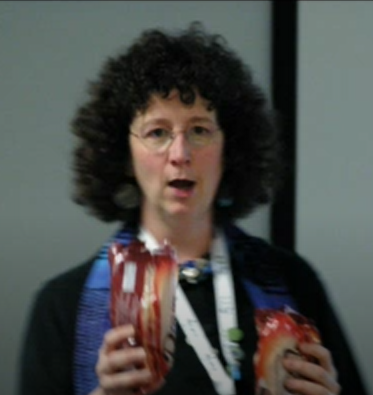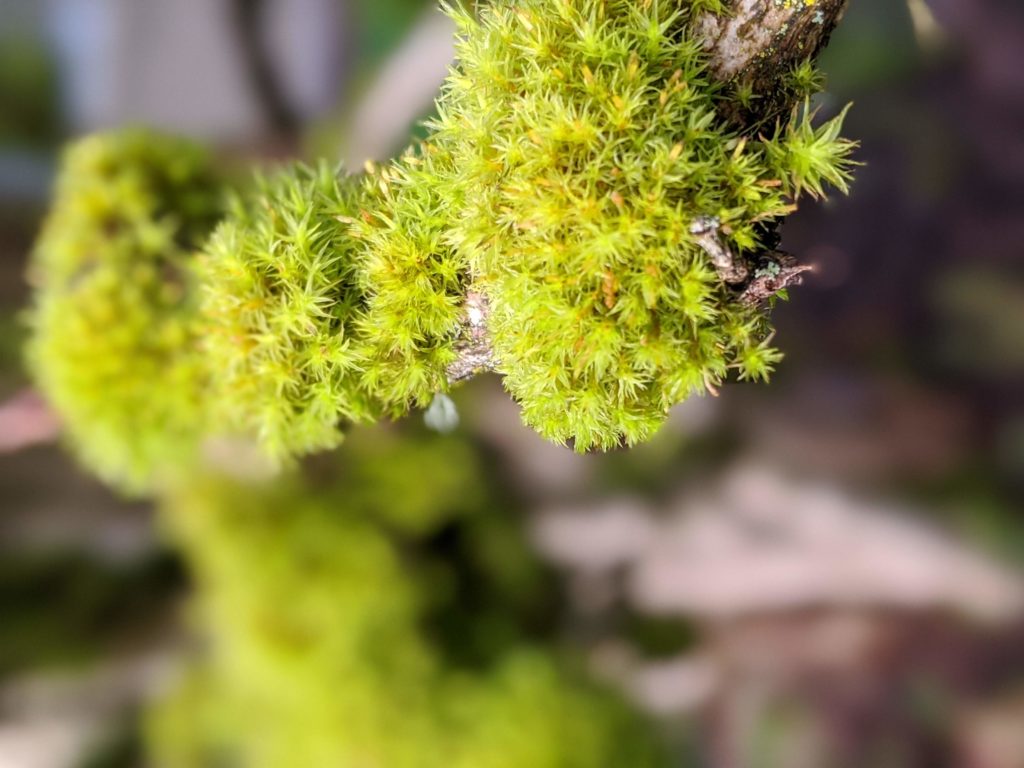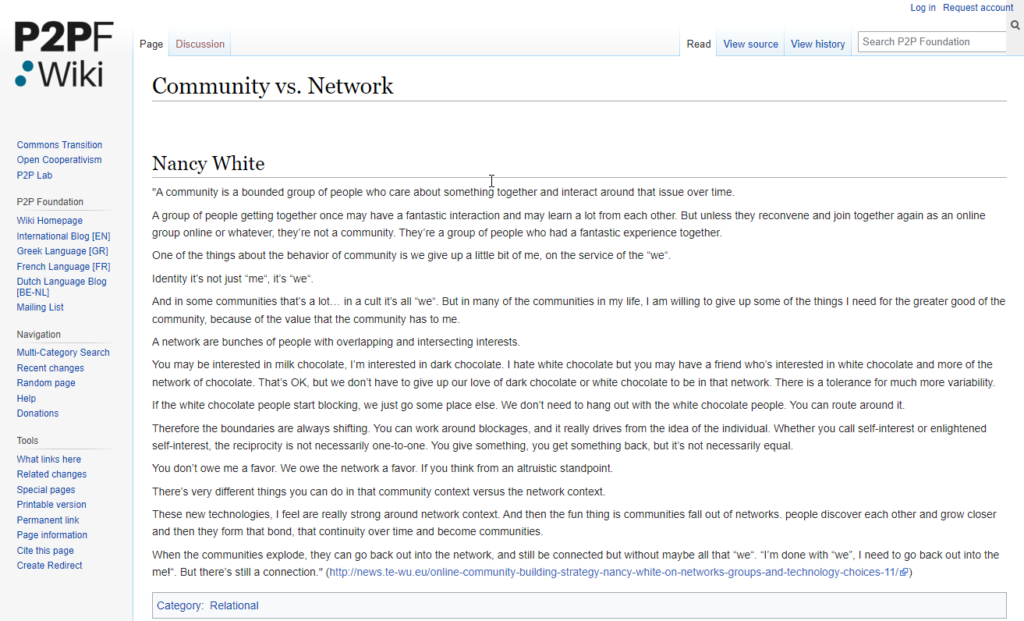 I found another almost intact unpublished post from 2008. It still resonates for me. For you?
I found another almost intact unpublished post from 2008. It still resonates for me. For you?
Will Richardson sent out a tweet today noting the admissions page of the College of the Atlantic. This line caught my eye. (Alas, dead link… this is what happens when you resurrect a 13 year old blog draft. I can’t find the text on their site now..)
Community isn’t a one-shot deal; it’s at the heart of daily life here.
Amen! Community is fabric, not container. It is, to use a word I love, quotidian. Peter Block (see this blog post) talks about successful communities being “slow, small and underfunded.” So then what does this mean in terms of networks? Are they a one shot deal? Fast? Certainly large is a property of many of the successful networks I’m a part of. (I’ll leave the funding issue alone today!)
I keep thinking every day about what makes community different from network. Just when I think I have it figured out, my logic falls apart, even when I try to squirrel out of it and say “this is all a continuum and of course, context matters.” Argggg.
This weekend I was introduced to Blip.fm – a network of people sharing links to music they love, Twitter style. (Update – it is now more of a way to be an internet based DJ, so it evolved a bit.) I have also been playing Amy Jo Kim and Shufflebrain’s “Photograb” puzzles in Facebook. (I don’t think these exist anymore either!) There is something about both of these networks that strike a “community chord” in me. Part of it is that both are well designed with game dynamics in mind, something Amy Jo has written about. Awards, “props” and various forms that reify participation and support reciprocity. I liken it to addiction to chocolate. 🙂 There is something you want more of. That is the gaming property that draws us back. But that addiction is not the “community-like” property of either of these sites that I’m sensing.
Is there a community property to Blip.fm and Photograb? I think so. But let me step back a bit. And, true to form, ramble. Yes, I’m thinking out loud, so don’t sink the following in concrete. Make it better by commenting!
My personal experience and definition of community is a group of people who care about something in common, and who interact with and have some sort of relationship with each other over time. Community has some boundary, however fuzzy and ineffable. It has interactions that are in some degree or other shared amongst all or most of the members. Things overlap. The boundary is a core part of the identity of a community and members are willing to have some degree of collective, not just individual, identity.
Networks are, by contrasts, collections of relationships (represented by nodes) that are not equal nor reciprocal over the network and where interests are overlapping, not necessarily congruent. Individual identity has primacy over network identity (if, in fact, any network identity is explicitly expressed.) Network relationships are defined by the nodes, not the boundaries of the network –if there are even boundaries. For example, membership in Blip.fm is a boundary, but not one that an individual can really fathom in terms of relationships because, come on, we don’t have “relationships” with thousands of people. Which begs the definition of relationship, eh?
In my experience, we form relationships in communities based on the person first, then their role and participation in the community. In networks we often form connections based on the content another person adds to the network. A puzzle on Photograb. A great tune on Blip.fm. We then nurture that connection and, if we like what we see, we may choose to activate that connection into a relationship. So trust, if I may use that word, is based on artifacts not personal relationships, at least at the start.
Given enough overlapping relationship, a community may form within that network. That’s why I think networks are so powerful as community incubators. This is a far more sustainable and scalable community formation path than someone saying “we need a community on X topic and I’m going to build it.”
Building implies a space. Community, remember, is fabric. Or ecosystem. It needs place, but it is not place itself. It needs time. It needs more than a container. But I’m getting off track, yet again. Sigh.
So are networks one shot deals? Often, yes. If we don’t get sufficient value out of a connection, we move on. If the content provided by the network doesn’t add value, we move on. The cost of sampling is not too high and the risk of disappointing or souring a relationship with another network member is low.
But networks are not by default one shot deals. If so, then what causes us to persevere in our networks? To stay connected? To create the possibility of community emergence?
Back to my thought about the possibility of “community-likeness” of Blip.fm and Photograb. Two things were in mind before I started playing with Photograb and Blip. That was value and relationship. Value is what we get out of something we participate in. You learn something. Have fun. Get work done. Relationship is the ongoing interaction we have with other individuals. Networks give us connections so we can create/find/nurture sets of connections that have short or long term value.
But it dawned on me today that, for me, a third reason cropped up today. Beauty. Or maybe pleasure is the word. In the case of Blip.FM and Photograb, both bring me non-text experiences that give me visual and aural pleasure. I’m smiling and grooving now to the music on Blip.fm and am truly appreciative of the individuals who took the time to share what they love and fill my little office with music. I’m madly giving them “electronic props” on the system to express my appreciation. (Nice design, Blip.fm!)
I’m taken back to the same feeling when I share a communal meal or a walk in a beautiful place with members of my communities.
The shared experience of beauty. In both communities and networks.
I’m gobsmacked I had not noticed this before.
But then again, community is not a one shot deal. Networks don’t have to be either. Through perseverance, I keep learning something. Ah, now there is another property or value provided by both networks and communities — learning.




 I found another almost intact unpublished post from 2008. It still resonates for me. For you?
I found another almost intact unpublished post from 2008. It still resonates for me. For you?